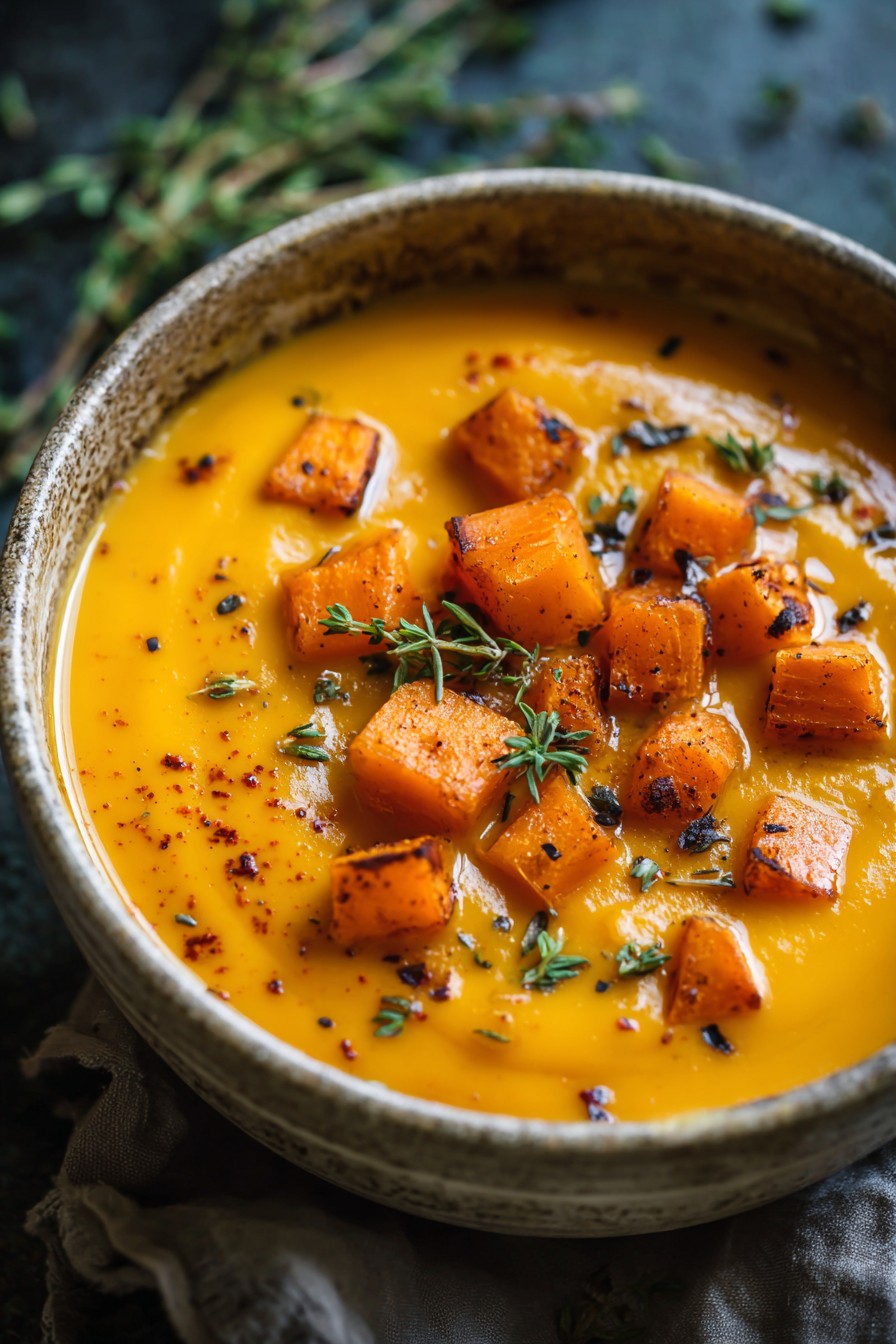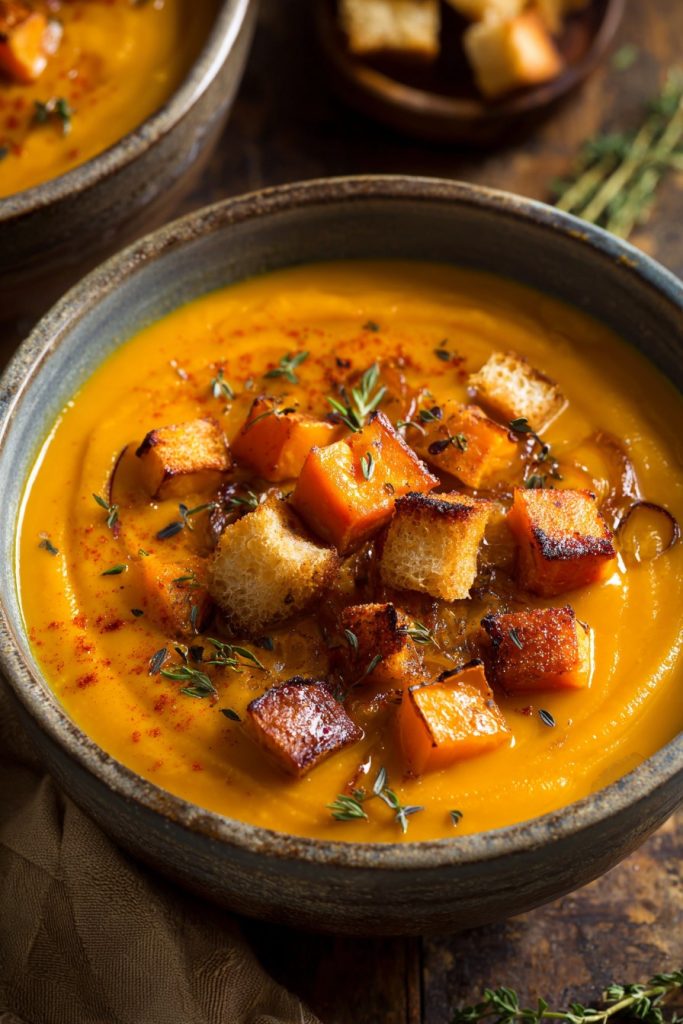A chill in the air always takes me back to my grandmother’s kitchen, where the scent of roasting squash and sweet potatoes would wrap around you like a warm blanket. As the leaves turned crimson and gold outside her farmhouse window, she’d stand at that old cast-iron stove, wooden spoon in hand, creating the most magical pot of golden soup that could mend any broken spirit or cold day. This recipe carries forward that same soul-warming magic, passed down through generations but forever tasting of childhood security and unconditional love.
Why This Recipe Works
- The combination of butternut squash and sweet potatoes creates a naturally sweet, velvety base that needs minimal added sugar, allowing the earthiness of these autumn vegetables to shine through in every comforting spoonful.
- Roasting the vegetables first caramelizes their natural sugars and deepens the flavor profile tremendously, transforming what could be a simple puree into a complex, layered soup that tastes like it simmered for hours rather than minutes.
- Using both vegetable broth and coconut milk provides the perfect balance between savory depth and creamy richness, creating a luxurious texture that feels indulgent while remaining completely plant-based and nourishing for the whole family.
- The subtle warmth from fresh ginger and aromatic herbs like thyme and sage evokes memories of holiday gatherings and Sunday suppers, making this soup taste like home itself in liquid form.
- This recipe freezes beautifully, allowing you to capture the essence of autumn in your freezer and bring back those cozy memories on even the bleakest winter days when you need a taste of comfort most.
Ingredients
- 1 large butternut squash (about 3 pounds), peeled, seeded, and cut into 1-inch cubes
- 2 large sweet potatoes (about 2 pounds), peeled and cut into 1-inch chunks
- 1 large yellow onion, roughly chopped
- 3 cloves garlic, minced
- 1 tablespoon fresh ginger, grated
- 4 cups vegetable broth
- 1 cup full-fat coconut milk
- 2 tablespoons olive oil
- 1 teaspoon fresh thyme leaves
- 1/2 teaspoon dried sage
- 1/2 teaspoon smoked paprika
- 1/4 teaspoon ground nutmeg
- Salt and freshly ground black pepper to taste
- 2 tablespoons pure maple syrup
- 1 tablespoon apple cider vinegar
Equipment Needed
- Large baking sheet
- Parchment paper
- Large stockpot or Dutch oven
- Immersion blender or standard blender
- Cutting board and chef’s knife
- Vegetable peeler
- Measuring cups and spoons
- Wooden spoon
Instructions

Preparing and Roasting the Vegetables
I always begin this soup the way my grandmother taught me – by preparing the vegetables with care and attention. Preheat your oven to 400°F and line a large baking sheet with parchment paper. In a large bowl, toss your cubed butternut squash and sweet potatoes with 1 tablespoon of olive oil until they’re evenly coated, then spread them in a single layer on the prepared baking sheet. The key here is giving them enough space – if they’re crowded, they’ll steam rather than roast, and we want that beautiful caramelization that comes from proper roasting. Season generously with salt and pepper, then slide the tray into the preheated oven. Roast for 35-40 minutes, rotating the pan halfway through, until the vegetables are tender when pierced with a fork and have developed those gorgeous golden-brown edges that signal perfect caramelization. The aroma filling your kitchen at this stage will transport you straight back to those autumn afternoons of childhood, waiting impatiently for dinner while the world outside grew colder.
Sautéing the Aromatics
While the vegetables roast, heat the remaining tablespoon of olive oil in a large stockpot or Dutch oven over medium heat. Add your chopped onion and cook, stirring occasionally, for about 8-10 minutes until they become translucent and just begin to take on a golden hue. This slow cooking of the onions is crucial – it develops their natural sweetness and forms the flavor foundation of your soup. Add the minced garlic and grated ginger, cooking for just one minute more until fragrant. Be careful not to burn the garlic, as burnt garlic can introduce a bitter note that would overwhelm the delicate sweetness of our roasted vegetables. The combination of scents at this stage – the earthy ginger, pungent garlic, and sweet onion – creates an aromatic base that will make your entire house smell like the coziest kitchen imaginable.
Combining and Simpering
Once your roasted vegetables have developed those beautiful caramelized edges, carefully add them to the pot with your sautéed aromatics. Pour in the 4 cups of vegetable broth, then add the fresh thyme leaves, dried sage, smoked paprika, and ground nutmeg. Bring everything to a gentle boil over medium-high heat, then reduce the heat to low, cover the pot, and let it simmer for 20 minutes. This simmering time allows all the flavors to marry beautifully – the sweetness from the roasted vegetables melding with the savory broth and aromatic herbs. I always think of this as the “getting acquainted” phase, where all the ingredients become friends and learn to work together in harmony, much like family members gathered around the dinner table.
Blending to Perfection
After your soup has simmered and the flavors have fully developed, it’s time to create that signature velvety texture. Remove the pot from heat and carefully blend the soup using an immersion blender until completely smooth. If you’re using a standard blender, work in batches, filling the blender no more than halfway each time and holding the lid firmly in place with a kitchen towel to prevent any accidents from the steam. This blending process transforms the humble vegetables into a luxurious, silky soup that feels like liquid velvet on your tongue. The transformation always reminds me of how simple ingredients, when treated with care and combined with love, can become something truly extraordinary and soul-nourishing.
Finishing Touches and Serving
Once your soup is perfectly smooth, stir in the coconut milk, maple syrup, and apple cider vinegar. The coconut milk adds incredible creaminess while keeping the soup dairy-free, the maple syrup enhances the natural sweetness of the vegetables, and the apple cider vinegar provides just enough acidity to balance everything beautifully. Taste and adjust seasoning with additional salt and pepper if needed. Let the soup heat through gently over low heat for about 5 minutes, but do not allow it to boil after adding the coconut milk. Serve hot, garnished with a drizzle of coconut milk, a sprinkle of smoked paprika, or some toasted pumpkin seeds if you’re feeling fancy. This final step completes the transformation from simple ingredients to a bowl of pure comfort that tastes like autumn itself.
Tips and Tricks
When selecting your butternut squash, look for one that feels heavy for its size with a firm, matte skin – these tend to be the sweetest and most flavorful. If you’re dealing with a particularly tough squash, I’ve found that microwaving it for 2-3 minutes before cutting makes it much easier to handle, much like my grandmother’s trick of using a kitchen towel for better grip. For the sweet potatoes, the orange-fleshed varieties work best as they provide that beautiful golden color and natural sweetness that makes this soup so special. When roasting the vegetables, don’t be tempted to crowd the pan – using two baking sheets if necessary ensures proper caramelization rather than steaming. If you find yourself short on time, you can use pre-cut butternut squash from the grocery store, though I find the flavor is always better when you cut it fresh yourself. For an extra layer of flavor, consider roasting a head of garlic along with your vegetables – simply slice the top off a whole garlic bulb, drizzle with olive oil, wrap in foil, and roast alongside your squash and sweet potatoes. When blending, if you prefer a chunkier soup, you can blend only half and leave the rest with more texture – this variation always reminds me of how my mother would make it slightly different each time depending on her mood. For storage, this soup keeps beautifully in the refrigerator for up to 5 days and freezes exceptionally well for up to 3 months. I often double the recipe and freeze individual portions for those days when I need a quick taste of comfort. When reheating frozen soup, thaw it in the refrigerator overnight first, then warm it gently on the stove, adding a splash of broth or water if it has thickened too much. If you’re serving this to guests, consider preparing some gourmet garnishes like crispy sage leaves fried in butter, toasted coconut flakes, or spiced pepitas to elevate the presentation. For those who enjoy a bit of heat, a pinch of cayenne pepper or a drizzle of chili oil added at the end can provide a wonderful contrast to the soup’s natural sweetness.
Recipe Variations
- For a creamier, dairy-based version, substitute the coconut milk with heavy cream or half-and-half, and consider stirring in a quarter cup of grated Parmesan cheese at the end for added richness. This variation always reminds me of the version my aunt would make for holiday gatherings, where everything felt a bit more indulgent and celebratory.
- To add protein and make it more substantial, stir in a can of rinsed white beans or chickpeas during the final heating stage, or top each bowl with shredded rotisserie chicken or cooked sausage crumbles for those who prefer meat in their meals.
- For an Asian-inspired twist, replace the thyme and sage with fresh lemongrass and a tablespoon of red curry paste, then garnish with cilantro and a squeeze of lime juice just before serving – this version brings back memories of culinary experiments in my college apartment.
- Create a smoky southwestern version by adding a teaspoon of chipotle powder instead of smoked paprika, and serve topped with avocado slices, corn kernels, and a dollop of sour cream or Greek yogurt for cooling contrast.
- For apple orchard nostalgia, add two peeled and chopped apples to roast with the vegetables, and use apple cider instead of some of the vegetable broth – this variation always tastes like autumn in New England to me.
Frequently Asked Questions
Can I make this soup ahead of time?
Absolutely, and in fact, I often argue it tastes even better the next day after the flavors have had more time to meld together. This soup will keep beautifully in the refrigerator for up to 5 days when stored in an airtight container. When reheating, you may need to add a splash of vegetable broth or water as it tends to thicken upon standing. I find that gentle reheating over medium-low heat, stirring occasionally, yields the best results. If you’re planning to freeze it, I recommend omitting the coconut milk until you’re ready to serve, as dairy and dairy alternatives can sometimes separate when frozen and reheated.
What can I use if I don’t have an immersion blender?
If you don’t have an immersion blender, a standard countertop blender works perfectly well, though you’ll need to work in batches for safety. Fill your blender no more than halfway with the hot soup, remove the center piece from the lid to allow steam to escape, and cover the opening with a clean kitchen towel while blending. You could also use a food processor, though the texture might not be quite as smooth. For those who prefer a more rustic, chunky soup, you could simply mash the vegetables with a potato masher for a heartier texture that reminds me of the way my grandfather preferred his soups.
Can I make this soup in a slow cooker?
Yes, this adapts wonderfully to slow cooker preparation, though I’d recommend still roasting the vegetables first to develop that deep, caramelized flavor. After roasting, simply add all ingredients except the coconut milk, maple syrup, and vinegar to your slow cooker and cook on low for 6-8 hours or high for 3-4 hours. Then blend directly in the slow cooker using an immersion blender, or transfer to a standard blender in batches. Stir in the remaining ingredients during the last 30 minutes of cooking. This method is perfect for busy days when you want to come home to a ready-made meal that fills the house with comforting aromas.
Is this soup freezer-friendly?
Extremely freezer-friendly! This soup freezes beautifully for up to 3 months. I recommend cooling it completely first, then portioning it into freezer-safe containers or heavy-duty freezer bags, leaving about an inch of headspace for expansion. For easiest serving, consider freezing individual portions that can be quickly reheated for lunches or quick dinners. When ready to enjoy, thaw overnight in the refrigerator or use the defrost setting on your microwave, then reheat gently on the stove. The texture might separate slightly after freezing, but a good stir or quick blend with an immersion blender will restore its creamy consistency.
Can I make this soup spicy?
Certainly! There are several ways to add heat to this soup depending on your preference. For subtle warmth, add a pinch of cayenne pepper or red pepper flakes when you add the other spices. For more pronounced heat, include a diced jalapeño or serrano pepper when sautéing the onions. If you enjoy smoky heat, chipotle powder or a small amount of minced chipotle in adobo sauce would complement the other flavors beautifully. For those who want control over the spice level, serve the soup with hot sauce on the side so each person can customize their bowl to their preferred heat level.
Summary
This butternut squash sweet potato soup captures the essence of autumn comfort, blending nostalgic flavors with creamy texture in a bowl that feels like coming home. Perfect for cozy evenings and family gatherings, it freezes beautifully for future comfort cravings.
Butternut Squash Sweet Potato Soup
4
servings20
minutes65
minutesIngredients
Instructions
- 1 Preheat oven to 400°F. Toss butternut squash and sweet potatoes with 1 tablespoon olive oil, spread on parchment-lined baking sheet, and roast for 35-40 minutes until tender and caramelized.
- 2 Heat remaining olive oil in large pot over medium heat. Cook onion for 8-10 minutes until translucent, then add garlic and ginger, cooking 1 minute more until fragrant.
- 3 Add roasted vegetables to pot with vegetable broth, thyme, sage, smoked paprika, and nutmeg. Bring to boil, then reduce heat, cover, and simmer for 20 minutes.
- 4 Remove from heat and blend until completely smooth using immersion blender or standard blender in batches.
- 5 Stir in coconut milk, maple syrup, and apple cider vinegar. Heat through gently for 5 minutes without boiling. Adjust seasoning and serve hot.



